This post for technical value, in case someone is searching for something similar in the future. I know EAS is not for everybody, but it suits this original RRC perfectly, and I really enjoy the benefits. The EAS ride is fantastic and this system has been in service for over four years.
Back in 2015 I picked-up a super low mileage (49k) RRC LWB, with intact EAS. The EAS was one of the key factors in targeting a new-to-me RRC, but most systems have been removed and not survived. Here is a brief overview of my EAS rebuild and manual inflation recovery system. In addition to what’s noted below, I also inspected every collet and replaced every O-ring in the system, rebuilt the valve block, replaced the drier and intake filter, but still run the original EAS compressor.
* * * * * * * * * * * * * *
First job was to replace the original (and age cracking) air bladders. You can find replacements on the web and from various LR parts suppliers, but I decided to go with genuine Dunlop bladders rebuilt on the original upper/lower pistons.
The action plan was replace all four air bladders, then run remote manual fill lines to circumvent a non-recoverable system fault.
Here is the parts stash.
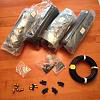
NEW Dunlop bladders from the UK.
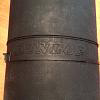
Original front bladder in place. Note the date code - 2/94 - that says a lot right there!
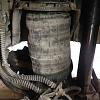
This photos shows the new bladder, next to the original "complete" assembly. Yes there is a size difference!
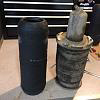
What makes this a challenge is getting the new, tighter, longer bladder to fold-over on itself so you can re-install it. Done right you end-up with something like this.

This is a tough exercise, and I can still feel it in my hands and forearms. I made a short manual fill line to charge the bladder, then loosened the fitting for a slow, controlled air-loss, while man-handling the lower bladder/piston interface. Basically you put your hands around the bladder and force it downward with all your might, once it starts to fold over you have to fight even harder so as not to loose any ground! This is tough! You have to move quickly before too much air escapes, constrict the bladder hard enough to force it downward while not too hard to prevent progress...
Everything out, fronts done, and about to clean the rear pistons.
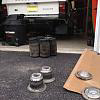
Same situation for the rears...
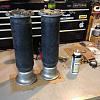
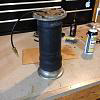
Now on to the manual emergency fill lines. Basically I wanted a few options before throwing in the towel. Option-1 would be to manually inflate each corner. Option-2 would be to manually inflate, and isolate, 1-4 corners. Anything beyond this would fall into remote recovery, for which I carry a self-made EAS repair kit, spare compressor, fittings and two spare bladders. Crazy? Not as crazy as leaving a vehicle like this, in the middle off nowhere, parked on it's bumpstops.
I installed a Y-fitting at each air bag, and ran a separate second air line back to the engine bay. The single branch on the "Y" is open and runs direct to the bag itself, while the other two "feeds" have a check valve feature - I could disconnect either or both feeds with no loss of air. I figured this as a second line of defense.
Here is the bracket and a preview of the fittings.

Here is the finished Manual EAS recovery interface under the bonnet.


* * * * * * * * * * * * * *
As mentioned above, this system has been running for over four years. I routinely park the vehicle in the highest setting, but hit all ride heights when I’m out using the vehicle. I don’t subject this RRC to salted roads, and the bladders hold height all Winter. If I happen to park in normal height, I can hit the manual fill valves with a few seconds of compressed air - raises it up to extended height, slip in a pair of jack stands and go about routine maintenance without even starting the vehicle.
Regards,
Tom P.
Back in 2015 I picked-up a super low mileage (49k) RRC LWB, with intact EAS. The EAS was one of the key factors in targeting a new-to-me RRC, but most systems have been removed and not survived. Here is a brief overview of my EAS rebuild and manual inflation recovery system. In addition to what’s noted below, I also inspected every collet and replaced every O-ring in the system, rebuilt the valve block, replaced the drier and intake filter, but still run the original EAS compressor.
* * * * * * * * * * * * * *
First job was to replace the original (and age cracking) air bladders. You can find replacements on the web and from various LR parts suppliers, but I decided to go with genuine Dunlop bladders rebuilt on the original upper/lower pistons.
The action plan was replace all four air bladders, then run remote manual fill lines to circumvent a non-recoverable system fault.
Here is the parts stash.

NEW Dunlop bladders from the UK.

Original front bladder in place. Note the date code - 2/94 - that says a lot right there!

This photos shows the new bladder, next to the original "complete" assembly. Yes there is a size difference!

What makes this a challenge is getting the new, tighter, longer bladder to fold-over on itself so you can re-install it. Done right you end-up with something like this.

This is a tough exercise, and I can still feel it in my hands and forearms. I made a short manual fill line to charge the bladder, then loosened the fitting for a slow, controlled air-loss, while man-handling the lower bladder/piston interface. Basically you put your hands around the bladder and force it downward with all your might, once it starts to fold over you have to fight even harder so as not to loose any ground! This is tough! You have to move quickly before too much air escapes, constrict the bladder hard enough to force it downward while not too hard to prevent progress...
Everything out, fronts done, and about to clean the rear pistons.

Same situation for the rears...


Now on to the manual emergency fill lines. Basically I wanted a few options before throwing in the towel. Option-1 would be to manually inflate each corner. Option-2 would be to manually inflate, and isolate, 1-4 corners. Anything beyond this would fall into remote recovery, for which I carry a self-made EAS repair kit, spare compressor, fittings and two spare bladders. Crazy? Not as crazy as leaving a vehicle like this, in the middle off nowhere, parked on it's bumpstops.
I installed a Y-fitting at each air bag, and ran a separate second air line back to the engine bay. The single branch on the "Y" is open and runs direct to the bag itself, while the other two "feeds" have a check valve feature - I could disconnect either or both feeds with no loss of air. I figured this as a second line of defense.
Here is the bracket and a preview of the fittings.

Here is the finished Manual EAS recovery interface under the bonnet.


* * * * * * * * * * * * * *
As mentioned above, this system has been running for over four years. I routinely park the vehicle in the highest setting, but hit all ride heights when I’m out using the vehicle. I don’t subject this RRC to salted roads, and the bladders hold height all Winter. If I happen to park in normal height, I can hit the manual fill valves with a few seconds of compressed air - raises it up to extended height, slip in a pair of jack stands and go about routine maintenance without even starting the vehicle.
Regards,
Tom P.
Last edited: